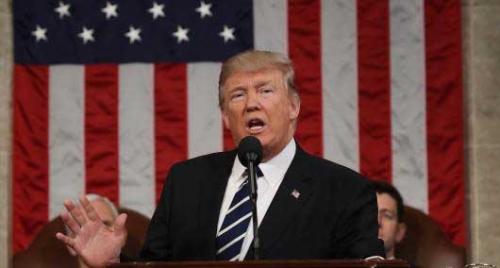
Last night President Donald Trump entered the chamber of the House of Representatives to speak to a joint session of Congress after what is likely the most volatile first month of any presidency in our nation’s history. From his Executive Order linking Muslims with terrorism but banning Muslims from countries from which there is no evidence of citizens committing acts of terrorism in this country, to his blatant attacks on journalists, the 45th president came into last night’s speech as the ‘Divider-in-Chief.’
The president stood at the podium last night facing perhaps the most divided Congress to ever serve our country. And divided in a number of ways. For Republicans, the majority, there was an obvious attempt to show a unified front despite growing concerns being voiced within the Republican Caucus over the administration’s relationship with Russia, its plan to repeal the Affordable Care Act and the level of spending the Trump administration is suggesting for the FY’ 18 budget. Democrats in the House and Senate have taken the role of loyal opposition seriously with female lawmakers wearing white in solidarity with women. According to some news reports, Minority Leader Nancy Pelosi instructed Democrats to be respectful of the president; a contrast to the treatment of President Obama when South Carolina Republican Rep. Joe Wilson shouted “You Lie!” in the middle of a State of the Union address. However, the Democratic Party faces its own internal battle as the choice of its new chairman, former Labor Secretary Tom Perez, has many progressive unsatisfied and declaring their willingness to wage war on the party’s leadership to push it farther left.
Trump’s speech began with an odd salute to Black History Month with no real recognition of the contributions of African-Americans but an awkward turn in recognizing attacks on Jewish cemeteries and the killing of an Indian citizen in Kansas City. Perhaps the controversy over aide Kelly Anne Conway’s behavior when a delegation of presidents from the nation’s historically Black colleges visited the Oval Office on Monday tempered the president’s willingness to call attention to the contributions of Blacks to the nation. It was a bizarre moment, citing Black History Month in name while avoiding any specific mention of the contributions Blacks have made to our country.
President Trump, for the very first time in his presidency, and that includes his inauguration, sought to portray himself as more than a loose cannon and delivered a speech that was traditional and filled with a wish list of policy items that his own party will find difficult to support. Though his delivery was in keeping with the decorum that a joint address to Congress compels a president to exhibit, it was nonetheless filled with the hyperbole Trump has displayed throughout his career. There was a veiled reference to the election as if to remind the public that he won. He claimed an overwhelming mandate from the American public though he lost the popular vote to his Democratic opponent, Hillary Clinton. Trump once again characterized the nation’s cities as hotbeds of violence and distress, and painted a picture of an America overrun by violent gangs and criminally disposed immigrants. There was no hopefulness in his message, just an egomaniacal view that he has been sent to deliver us from our torment.
The president followed his campaign script and outlined an agenda that includes spending $1 trillion on the nation’s infrastructure, an effort he couched as a public-private partnership, increasing military spending by $54 billion, building a $20 billion security wall on the nation’s southern border to stop immigrants from Mexico entering the country illegally, repealing the Affordable Care Act (Obamacare) but keeping several of its provisions, attacking violence in America’s cities and supporting law enforcement, and offering children a choice in public education by providing vouchers. What was missing from his speech was any sense on how the administration intends to pay for his agenda. Trump has previously claimed he has no intention of cutting entitlement programs and has insisted he will push “big, big” tax cuts for companies and tax relief for the middle class, so his only options to significantly increase discretionary spending is to cut social programs, a small proportion of federal spending, or run huge deficits.
What comes next is the usual political wrangling on Capitol Hill over the budget. This budget cycle however will be marked by dissension and opposition to some of the president’s proposals that is likely to cross party lines. Republican House members have been bombarded with complaints during town hall meetings in their districts; mostly from constituents demanding that the protections of Obamacare are preserved. Some in the GOP are also skeptical of the massive increased in military spending while the State Department and the nation’s diplomacy machinery appears to be an afterthought to the Trump White House. Though there were cheers from Republicans in the chamber when the president declared that the Mexican wall will be built, it remains to be seen how they react when their constituents object to paying for a wall this president claimed during the campaign that he would force Mexico to pick up the tab.
Despite his attempt to gloss over the stark divisions in the nation’s capital and appeal for unity, President Trump left the Capitol last night reinforcing the deep fissures in America that threaten to tear the country apart.

today in black history
January 06, 2026
In 1989 Rep. John Conyers (D-MI) introduced a resolution calling for reparations to compensate African-Americans for slavery.
The State of Disunion
POSTED: March 01, 2017, 2:00 pm



















